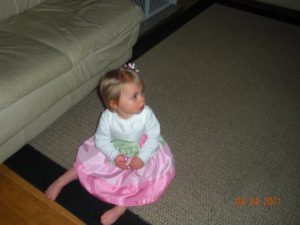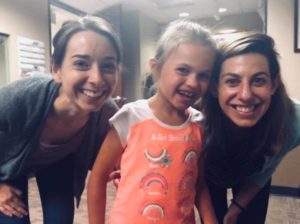Apraxia, dyspraxia, dysarthria and the link that tied them all together.
Those familiar with my story know that I missed apraxia in Ashlynn because I was convinced she had CP (cerebral palsy). She had a significant birth history and had to be pulled out via C-section and all of her motor milestones were late.
Tummy time was a nightmare. I was always so stressed about it because she literally seemed like she was suffocating and couldn’t pull herself up for air. She would cry. As much as I tried to prevent it she developed a flat head. I remember asking the pediatrician if she needed a helmet but was told no. From 3-6 months she had developed a case of extremely pointy toes. My friend affectionately referred to them as ballerina toes, but they were anything but cute. I couldn’t get them flexed at all. I kept thinking they just looked “spastic” to me; which is a term to describe very tight muscles in individuals with CP.
When I brought it up to the pediatrician she said we could go to neurology or maybe I could just massage her calves every night in the bathtub and at her next baby well visit we would evaluate. I decided to do that and if it didn’t work I would go to neurology. I worked as a speech/language pathologist before she was born in severe needs classrooms and worked alongside physical therapists. I did to Ashlynn everything I would see them do to our students. By her next well baby visit, her feet could flex and she no longer had a standing ballerina toe pose. There didn’t seem a need for neurology at that point.
After that the rest is really history. I received her diagnosis of apraxia right before her 3rd birthday, and then subsequently got her dx of dyspraxia, SPD, and ADHD through various OT places we went for therapy. From that time on, I’ve accepted this was her diagnoses.
Last year I decided I wanted to make sure I had checked all the boxes and got a referral to neurology. It was not a good appointment. You can read about here. They completely dismissed any chance of CP, but they did write orders for an MRI and genetics and those were two boxes I wanted to check off. That all turned up empty. They dismissed any neurological soft signs I had seen such as her pointy toes, flat head, and choking as a baby. They actually dismissed dyspraxia and apraxia as well but that’s another story. I let it go again because these are experts after all.
That was until, a new development happened. Ashlynn’s toes are curling forward to the point you can’t see her toenails because it looks like she is standing on them. I took her back to the pediatrician who literally did not know who to refer me to. She sighed a deep sigh and took a good 20-30 seconds to speak. In the end, we decided on the orthopedic department at children’s, guessing it has something to do with her dyspraxia causing balance and coordination issues.
As fate would have it, I’m telling Ashlynn’s symptoms to the mom of a client who has severe CP and dysarthria. After I told her about our dr appointment and referral, she relayed to me that curling toes is common in CP, or any joint abnormalities for that matter, especially around the time of a growth spurt.
My heart sunk.
There is this feeling every mom can relate to. It is this gut feeling that tells you when something is right and when something is wrong in your child. At that moment, I immediately felt it. I knew that what I had thought all along was right. Ashlynn has CP, and this woman standing before me knew of the person I should go see.
She recommended I go to the rehab clinic at Children’s Hospital Denver who has a team of doctors who deal with this stuff. I called this place in lieu of the orthopedic department. The intake person went from being skeptical and asking me why I didn’t have a doctor referral to enthusiatically affirming she could get us in right away after I explained all of Ashlynn’s symptoms. She then told me that me once Ashlynn was diagnosed, they can recommend the best plan of treatment. When I got off the phone my mind was reeling. What had I told that person that made their attitude change from skeptic to a certain dx? I wasn’t sure, but at least I knew I was now on the right track to getting an accurate and complete dx for my daughter.
I’m a firm believer that coincidences are put in our path for a reason. It wasn’t a “coincidence” this client found me. She had in fact been referred to me by Dr. Ruth Stoeckel, who had been my mentor at the Apraxia-Kids bootcamp. I was about to experience another coincidence that would light the path to the answers I was seeking.
That same week I found out Ashlynn’s OT was leaving and a new OT would be shadowing her for the next two sessions. When I went in, I told them both about Ashlynn’s new doctor appointment and that it was because I had always suspected CP. The minute I said CP they both turned to each other, smiled, and then nodded in recognition.
I’m sure when they looked back at me I looked angry. Why on Earth would they suspect something like CP and not tell me? I quickly had my answer. The new OT had observed Ashlynn the week prior and after reading her chart suspected a mixed presentation of low and high tone. She suspected it, because she herself had CP as well.
My mouth probably dropped open.
That was a lot to process. For someone like me who believes coincidences are God’s way of telling us we are on the right path, this path was lit up like a Christmas tree and blinking. I knew my initial hunches way back when Ashlynn was a baby were about to be finally confirmed, almost 9 years later. I didn’t know what to feel.

